Sand bags are good but soon rot … i prefer this method
Ferro-cement is a method of construction ( there are many ways to do it but here is mine) where you make a frame of steel mesh (about 2 inch mesh) … and attach chicken wire to it every few links.
or start with EMPTY Gabion’s , ones of the right dimensions, — preferably a thinner type like 1 a foot thick or less – they are made in many sizes — 3 foot by 4 foot by 1/2 a foot and use them as you would bricks .. tying them together with wire, obviously with the 1/2 foot being the width of the wall.
kinda like this (please excuse mspaint art)

Then attach the chicken wire to the outside of the wall and what will form the inside and plaster .
Plaster with a very fine plaster mix on the chicken wire — let it set and re-plaster until its quite thick .. maybe 1 inch
if you dont use Gabions . make one ferro cement wall and then another a few cm’s appart, forming the outside of a hollow wall …- space them every few inches with ties to keep the side parallel.
then back fill the wall with whatever … concrete to form a structural solid wall, gravel cause its cheap , whatever you have handy. ( gravel works well – a filled gap of 15cm’s or 6 inches will stop most small arms upto a .50 cal and as i have said before was used during the Anglo-Boer war by the British in block house construction as it self heals when struck .. the gravel is displaced and then falls back to cover the hole )
let it set and it will be VERY strong … the outer wall being ferro cement and the inner being solid… ( or loose gravel 😉 )
you don’t really even have to fill it … when used in building for insulation, it will be very well insulated against cold and pretty light … and also very strong …but not bullet proof.
So strong in fact the boat hulls can be made from this stuff and they will be lighter and cheaper then fiberglass hulls of the same size …
the only concern is rust if the mixture gets bubbles in.. so compact it well …
Ferro cement is labor intensive to do but it is not that hard work as the materials are light (relatively), and can be undertaken by the older and less experienced .( if you use the Gabions it will go very quick)
Ferro cement is good for bunker construction because the walls you put up are essentially molds .. and once up, stay there, and don’t need to be brought down again, saving time, and the walls are even pre-plastered.
the cement to back fill can then be trucked in and poured straight into the gaps in the “mold”.
Imagine your bunker cast on one piece ?
Gabions can be used from many things but use in bunkers seams a logical progression.
Ferro-Cement can be used to make strong water tanks, and ponds, and pretty much anything that you would like from concrete.
Block houses in ZA
“The second blockhouse type, known as the Rice Pattern, was more suited to the military situation unfolding in South Africa during 1901. These corrugated iron blockhouses were named after Major SR Rice of the Royal Engineers who Lord Kitchener appointed to devise a more cost effective and mass producible method. Each Rice pattern blockhouse cost approximately £ 16 and took its garrison of between 7 – 10 men one day to erect.
Built from two layers of corrugated iron, the space between the interior and exterior layer was filled with sand, which rendered the blockhouse bullet proof. An exterior stone wall from ground level to loophole height reinforced the fort. The building materials could be transported overland by ox wagon so that Rice pattern blockhouses might be flung up wherever they were required. In many cases the corrugated iron required was looted from the roofs of Boer homesteads. By 1902, more than 8 000 Rice pattern blockhouses straddled the South African veld.”
And dont forget the other articles on my blog about this



